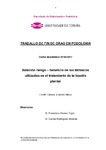Relación riesgo – beneficio de los fármacos utilizados en el tratamiento de la fascitis plantar
Title
Relación riesgo – beneficio de los fármacos utilizados en el tratamiento de la fascitis plantarAuthor(s)
Directors
Alonso Tajes, FranciscoRodríguez Moreno, Carlos
Date
2017Center/Dept./Entity
Universidade da Coruña. Facultade de Enfermaría e PodoloxíaDescription
Traballo fin de grao (UDC.FEP). Podoloxía. Curso 2016/2017Abstract
[Resumen] Analizar la eficacia, riesgos y beneficios de los tratamientos farmacológicos para la fascitis plantar aguda. Además, conocer si en la literatura científica se recoge la valoración de los riesgos previa aplicación del tratamiento farmacológico.
METODOLOGÍA
Se realizó la búsqueda en Scopus, MEDLINE y Web of Science. Los 167 artículos encontrados se enviaron a Refworks y, tras eliminar los duplicados, se obtuvieron 52 artículos. Finalmente, contamos con 7 ECAs y un meta-análisis. Las variables estudiadas fueron la edad, el sexo, el perfil del sujeto de estudio, el fármaco utilizado, sus beneficios/riesgos, el tiempo de seguimiento y el tamaño de la muestra.
RESULTADOS
La balanza beneficio/riesgo se inclina hacia la primera parte en los estudios. Seis artículos no mostraron reacciones indeseadas mientras en los otros dos se observó dolor e inflamación en la zona de punción que duró de 24-48h. La aplicación del tratamiento farmacológico redujo el dolor y la inflamación de la muestra, en mayor medida si se utilizaba la ecografía para guiar la aguja.
CONCLUSIÓN
No existe un consenso en la comunidad científica sobre la relación beneficio/riesgo presente en la aplicación de tratamientos farmacológicos para la fascitis plantar aguda. La realización de estudios bien diseñados podría ofrecer un protocolo que estandarice su aplicación en cuanto a la dosis, elección del fármaco, vía de administración, duración del efecto, educación del paciente e utilización de la ecografía en el proceso. [Abstract] To analyze the efficacy, risks and benefits of pharmacological treatments for acute plantar fasciitis. In addition, we want to know if the scientific literature collects the risk assessment before the application of drug treatment.
METHODS
We searched in Scopus, MEDLINE and Web of Science. The 167 articles found were sent to Refworks and 52 articles were obtained after removing the duplicates. Finally, we have 7 RCTs and one meta-analysis. The variables studied were age, sex, profile of the subject of study, drug used, benefits / risks, follow-up time, and sample size.
RESULTS
The benefit / risk balance of the included studies is inclined towards the first part. Six articles didn’t show undesirable reactions while in the other two was observed pain and inflammation in the puncture zone that lasted 24-48h. The application of pharmacological treatment reduced the pain and inflammation of the participants, even more if they were applied with ultrasound to guide the needle.
CONCLUSION
There is no consensus in the scientific community on the benefit / risk ratio present in the application of pharmacological treatments for acute plantar fasciitis. Well-designed studies could offer a protocol that standardizes its application in terms of dose, drug choice, route of administration, duration of effect, education of the patient and use of ultrasound in the process.
Keywords
Fascitis plantar
Fármacos
Plantar fasciitis
Drugs
Fármacos
Plantar fasciitis
Drugs
Rights
Os titulares dos dereitos de propiedade intelectual autorizan a visualización do contido deste traballo a través de Internet, así como a súa reproducción, gravación en soporte informático ou impresión para o seu uso privado e/ou con fins de estudo e de investigación. En nengún caso se permite o uso lucrativo deste documento. Estos dereitos afectan tanto ó resumo do traballo como o seu contido Los titulares de los derechos de propiedad intelectual autorizan la visualización del contenido de este trabajo a través de Internet, así como su repoducción, grabación en soporte informático o impresión para su uso privado o con fines de investigación. En ningún caso se permite el uso lucrativo de este documento. Estos derechos afectan tanto al resumen del trabajo como a su contenido






